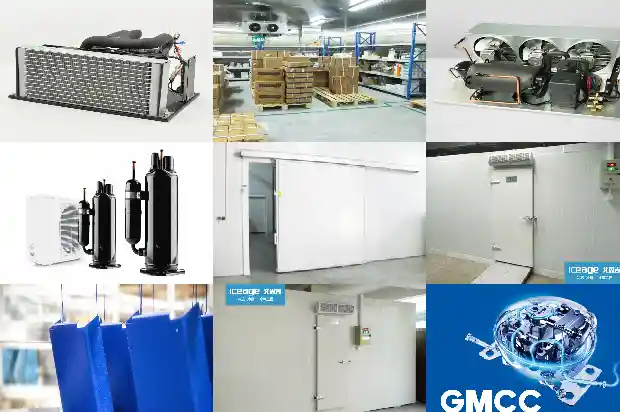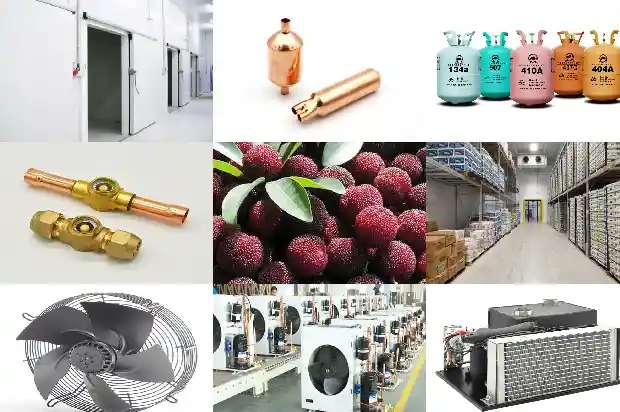Micro Refrigeration System
2025-03-05
A micro refrigeration system refers to a refrigeration device with a compact structure, relatively small geometric dimensions of its components, and a refrigeration capacity usually below 1 kW. It has the advantages of small size, light weight, and being convenient for distributed layout, and its application is becoming more and more widespread.
Background and Basic Information
Application Scenarios
(1) With the vigorous development of infrastructure construction in China, a large number of people work in extreme environments. The regulation of the temperature in the human microenvironment is of vital importance to their physical health.
(2) The cold chain logistics in China started late. According to statistics, the loss and decay rate of fruits and vegetables in cold chain circulation in China is as high as 25% to 30%.
(3) There is a huge market demand for portable micro refrigeration systems. With the development of large-scale integrated circuit technology and manufacturing technology, the volume of electronic devices is continuously decreasing, the power is increasing, and the heat generation per unit volume is getting larger and larger. According to statistics, 55% of the failures of electronic devices are due to the long-term use temperature exceeding the specified value. The heat dissipation problem of chips has become one of the main factors limiting their development.
Classification
(1) Passive cooling devices: mainly refer to "refrigeration" devices that provide cooling capacity by adding ice cubes and other means, such as water-cooled suits containing ice cubes and insulated boxes.
(2) Active cooling devices refer to refrigeration devices with an active cold source. Currently, the mainstream devices can be classified into vapor compression refrigeration, semiconductor refrigeration, and absorption refrigeration according to the principle of cooling capacity generation.
Micro Refrigeration Systems
The existing mainstream micro refrigeration systems can be divided into vapor compression refrigeration, absorption refrigeration, adsorption refrigeration, and semiconductor refrigeration according to different ways of generating cooling capacity. Different refrigeration methods have different advantages and disadvantages and are suitable for different occasions.
Micro Vapor Compression Refrigeration System
Vapor compression refrigeration is the earliest developed and most widely used refrigeration method, which has the advantages of large refrigeration capacity, high performance coefficient, and simple and reliable structure. According to statistics, currently 95% of the refrigeration systems belong to vapor compression refrigeration.
Application Scenarios
(1) With the vigorous development of infrastructure construction in China, a large number of people work in extreme environments. The regulation of the temperature in the human microenvironment is of vital importance to their physical health.
(2) The cold chain logistics in China started late. According to statistics, the loss and decay rate of fruits and vegetables in cold chain circulation in China is as high as 25% to 30%.
(3) There is a huge market demand for portable micro refrigeration systems. With the development of large-scale integrated circuit technology and manufacturing technology, the volume of electronic devices is continuously decreasing, the power is increasing, and the heat generation per unit volume is getting larger and larger. According to statistics, 55% of the failures of electronic devices are due to the long-term use temperature exceeding the specified value. The heat dissipation problem of chips has become one of the main factors limiting their development.
Classification
(1) Passive cooling devices: mainly refer to "refrigeration" devices that provide cooling capacity by adding ice cubes and other means, such as water-cooled suits containing ice cubes and insulated boxes.
(2) Active cooling devices refer to refrigeration devices with an active cold source. Currently, the mainstream devices can be classified into vapor compression refrigeration, semiconductor refrigeration, and absorption refrigeration according to the principle of cooling capacity generation.
Micro Refrigeration Systems
The existing mainstream micro refrigeration systems can be divided into vapor compression refrigeration, absorption refrigeration, adsorption refrigeration, and semiconductor refrigeration according to different ways of generating cooling capacity. Different refrigeration methods have different advantages and disadvantages and are suitable for different occasions.
Micro Vapor Compression Refrigeration System
Vapor compression refrigeration is the earliest developed and most widely used refrigeration method, which has the advantages of large refrigeration capacity, high performance coefficient, and simple and reliable structure. According to statistics, currently 95% of the refrigeration systems belong to vapor compression refrigeration.

- Refrigeration principle of the vapor compression system: The refrigerant circulates in the system, carrying heat from the evaporator side to the condenser side to achieve the purpose of refrigeration.
- The latest development of the micro vapor compression refrigeration system: For example, a micro vapor compression refrigeration system for personal cooling in high-temperature environments has been tested. The working fluid is R134a, the refrigeration capacity can reach 260 W, the coefficient of performance (COP) can reach 1.5 or above. The size of the whole set of equipment is 190mm×190 mm×100 mm, and the mass is 2.75 kg. It is powered by a lithium battery and can be worn by individuals.
Micro Absorption Refrigeration System
Compared with vapor compression refrigeration, absorption refrigeration has the following advantages: - It does not use working fluids such as CFCs and HCFCs that cause serious pollution to the atmosphere.
In recent years, countries around the world have increasingly emphasized the importance of environmental protection, and absorption refrigeration is of great significance.
- It uses low-grade heat energy as an energy compensation method and can play a huge role in energy conservation and emission reduction in aspects such as waste heat utilization.
However, absorption refrigeration also has disadvantages: - Compared with the vapor compression refrigeration cycle, the performance coefficient is lower, and the COP is usually below 0.5.
- The concentrated solution of the absorbent, for example, the most typical absorbent-refrigerant pair in absorption refrigeration, lithium bromide/water, is corrosive to the equipment.

- Principle of the absorption refrigeration system: The absorption loop of absorption refrigeration is equivalent to the compressor in vapor compression refrigeration. By absorbing the heat supplied from the outside, it raises the refrigerant gas from the state of low temperature and low pressure to the state of high temperature and high pressure, enabling the cycle to proceed.
Micro Semiconductor Refrigeration System
The semiconductor refrigeration system, also known as the thermoelectric refrigeration system, has no moving parts such as compressors and no refrigerant. Therefore, it has the characteristics of convenient control, reliable operation, flexible layout, and strong adaptability. It is widely used in small air conditioning systems. With the progress of materials science in recent years, the COP of this system has been continuously increasing, and its advantages compared with other micro refrigeration systems have become increasingly prominent. - Principle of the semiconductor refrigeration system: The Peltier effect is the basic principle of thermoelectric refrigeration. After a typical semiconductor cooler is connected to a DC power supply, when the current flows from the N-type semiconductor to the P-type semiconductor, it absorbs heat and forms a cold end. When the current flows from the P-type semiconductor to the N-type semiconductor, it releases heat and forms a hot end. The N-type and P-type semiconductors are arranged alternately to transfer heat from the cold end to the hot end to achieve the purpose of refrigeration.
Other New Micro Refrigeration Systems
In recent years, some new refrigeration methods have been applied to micro refrigeration systems, such as magnetic refrigeration, laser refrigeration, thermoacoustic refrigeration, etc. More and more new refrigerators have been designed and manufactured, and the refrigeration systems are constantly becoming more diversified.
Magnetic refrigeration refers to a refrigeration method that obtains cooling capacity by using magnetic refrigeration materials with the characteristics of exothermic magnetization and endothermic demagnetization. Due to its small system, no moving parts, reliable operation, and no environmental pollution, the application of magnetic refrigeration in micro refrigeration systems has been continuously expanding. Thermoacoustic refrigeration has the characteristics of simple structure, small mechanical vibration, long working life, and a wide range of energy sources, and it is convenient for miniaturization. It has great application prospects in aspects such as heat dissipation of microelectronics and integrated circuits.
Related Articles
- HVAC - Common Auxiliary Components of the Refrigeration System
- The Influence of Temperature Changes on the Air Conditioning Refrigeration System
- Analysis of the Main Functions and Components of Refrigeration Air Conditioners
- Valves in the Refrigeration System
- HVAC - Solving the 5 Common Problems in the Refrigeration System
- Eliminate the "Blockage" Faults (Ice Blockage, Dirt Blockage, Oil Blockage) of the Refrigeration System in 5 Minutes
- Brief Analysis of Commonly Used Automatic Control Devices in the Refrigeration System
- Forms and Structures of Oil Separators in the Refrigeration System
- Five Common Problems in the Refrigeration System~~ Solve Them One by One!
- Pipelines Used in the Refrigeration System
- Does a lower evaporation temperature result in a larger refrigeration capacity, or does a higher evaporation temperature lead to a larger refrigeration capacity?
- Energy - saving Control and Adjustment of Main Operating Parameters of the Refrigeration System
- HVAC - Concise Explanation of Refrigeration Principles
- Analysis of Common Auxiliary Components in the Refrigeration System One by One
- A Detailed Analysis of the Nine Reasons for the Low Pressure in the Refrigeration System!
- These Inspections before Starting the Refrigeration Unit Are Very Important~~
- Common Fault Causes of Totally Enclosed Refrigeration Compressors
- Popularize Refrigeration Knowledge You've Never Noticed, Which Is Actually Very Crucial
